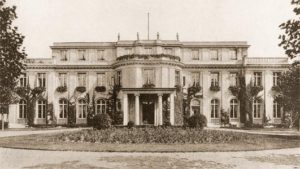Holocaust Survivors Mark Anniversary of Wannsee Conference by Testifying to the Reality of the Holocaust, Jan. 21, 1982.
 Members of Austrian Inmates of Auschwitz, an organization of death camp survivors, held a press conference here to testify to the reality of the Holocaust, its origins and the methodical way it was carried out. The occasion was the 40th anniversary of the meeting in Wannsee, a suburb of Berlin, where Reinhard Heydrich, who was chief of security of the SS, Adolf Eichmann, and a number of other Nazi bureaucrats decided how to implement the “final solution.”
Members of Austrian Inmates of Auschwitz, an organization of death camp survivors, held a press conference here to testify to the reality of the Holocaust, its origins and the methodical way it was carried out. The occasion was the 40th anniversary of the meeting in Wannsee, a suburb of Berlin, where Reinhard Heydrich, who was chief of security of the SS, Adolf Eichmann, and a number of other Nazi bureaucrats decided how to implement the “final solution.”
Herbert Langbein, a writer and former inmate of Dachau and Auschwitz, explained that the press conference was organized because there can never be an end to discussion of Nazi horrors. “We have to speak out because nowadays there is much confusion about all this, especially among young people,” he said.
Langbein added that neo-Nazi activities increase because the victims have been silent too long and Nazi propaganda finds an audience, especially the very young, who are open to the suggestion that the horrors of the Holocaust could not have happened and, therefore, did not.
Liquidation Proceeded ‘Final Solution’
Among the points made by Langbein and others at the press conference were that the liquidation of Jews began before the “final solution” was put into action and that not only Jews trapped in the Nazi-occupied countries, but those outside the Nazi orbit, including southern France and 300,000 Jews in England, were slated for murder. Altogether, more than II million Jews the world over were intended to be included in the “final solution,” the former inmates said.
They noted that racial theory existed in Germany long before the Wannsee meeting and that many people were killed, including disabled non-Jews, who the Nazis considered a drain on the economy. In 1941, protests by German churches resulted in an official halt of these liquidations, although, according to Langbein, they were continued covertly. Up to the fall of 1941, more than 500,000 Jews had been able to flee by their own means or with the assistance of Jewish and non-Jewish organizations. But in October, Heinrich Himmler ordered the borders closed to Jews, the press conference was told.
At the Wannsee conference, the Nazi officials planned the deportation of German and other West European Jews and Gypsies to camps in Eastern Europe. Four task forces, including members of the Waffen SS, were organized to carry out the systematic murder of most of the deportees on Polish or Russian soil.
The protocol agreed to at Wannsee stated that Jews were to be used as forced labor and that a high percentage of them would die of exhaustion and overwork. The remainder, being the most robust, would receive “appropriate treatment” because they could become the nucleus of a “new Jewish build-up.” The term “appropriate treatment” was a euphemism for murder.
Former Inmates Recall The Horror
The former inmates recalled that persons transported to the camps were selected according to their ability to work. Those who seemed weak were sent immediately to the gas chambers, Langbein said. At peak time, up to six transports a day arrived at Auschwitz, altogether about 2,000 persons, who were gassed immediately. Camps like Auschwitz could kill about 4,500 persons a day but the ovens could not burn that many corpses, so they were stacked out of doors.
In recent years, members of Austrian Inmates of Auschwitz have been touring high schools and speaking to the students about the Holocaust. Langbein observed that the youngsters were interested but uninformed.
The Wannsee conference anniversary was also marked in West Germany today where a band called Espe, which specializes in Yiddish songs, performed in the Taunus Hall in the federal state of Hessen. The concert was organized by members of a private group called After the Wannsee Conference as a gesture of solidarity with the Jewish people. Mayor Richard von Weizsaecker of West Berlin was the principal speaker.



